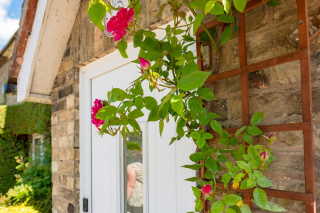As society takes a decidedly more environmentally conscious philosophy, many homeowners are searching for ways to decrease their carbon footprints and use less energy around their homes. Appliances and household amenities are more energy-efficient than ever before thanks to the new emphasis, but even with improvements, there are still additional efficiency goals that are within the grasp of homeowners to attain. After all, keeping your home energy-efficient isn’t just about the environment. It can also help you lower your energy bills significantly.
One handy tool that can be used to improve the energy efficiency of your home is landscaping. Clever landscaping designers are using common components of landscape design in Dacula, GA, to reduce the amount of energy needed in the average home. By implementing some smart design features into the residential landscape, homeowners can see a marked reduction in use of energy which translates to lower energy bills and less adverse impact on the environment. Keep reading to learn more about how you can use landscape design to reduce energy usage on your property.

Shading the Roof
While some homeowners shy away from overarching trees and branches that hang above their roofs, there’s something to be said about the shade that trees provide and how it can impact home energy usage. Much of the energy used by the average home stems from HVAC usage. It takes a lot of energy to heat and cool your home, and small improvements in the performance of your HVAC system can result in savings that are noticeable over time. Even lowering the temperature of your roof a few degrees can result in better HVAC performance because it prevents the transfer of roof heat to the attic, which in turn can be transferred to the interior of the home. A cooler roof means your HVAC doesn’t work as hard to maintain the target temperature.
Shading the Walls
Just as allowing shade to bathe the roof and keep it cool can impact your energy costs, so too can shading the walls. Though the outer walls of your home may not receive full sun throughout the day, there is some transferal of thermal energy from the outside of the walls to the surfaces inside, even when insulation is present in the wall. Therefore, planting shrubs near the wall can not only provide aesthetic benefits for your home, but they can also help keeps temperatures inside cooler which will take the load off your HVAC system.
Shade Thresholds
One of the most common locations for hot or cold outside air to penetrate the home is around the thresholds such as your front door or back door. Therefore, the hotter the air immediately outside the door, the more difficult it will be to maintain temperature on the interior of the door since outside air will be sucked in each time the door opens and closes. One landscaping tactic to help mediate that dynamic is to plant trellises or arbors near thresholds that will keep them shaded even in periods of full sun. That will minimize the impact of the outside air that inevitably penetrates your home around the doors and help reduce energy usage.

Shade Outdoor HVAC Components
Most modern air conditioners feature an outside unit that includes the system’s compressor. The compressor is essential in AC performance because it is one of the primary ways that heat removed from interior air is transferred into the outside environment. It’s far more effective when the outside ambient temperature is lower, so it makes sense to provide plant-derived shade to the compressor area. Lowering the temperature around the compressor can be beneficial and can reduce the workload of your AC, which will reduce energy usage. Be sure to leave plenty of space between plantings and the outside unit to increase airflow, however.
If you’re interested in boosting energy efficiency at your home and reducing your utility costs, consider incorporating the landscaping ideas designed to reduce energy usage. To learn more ways that you can save money and energy through landscape design, contact Stoeckig Landscape Group at (770) 831-1790.
